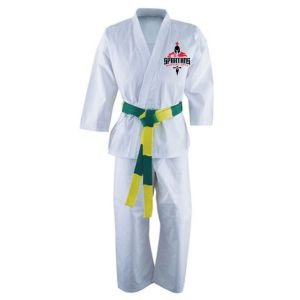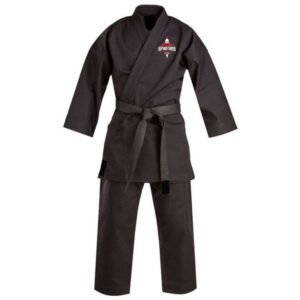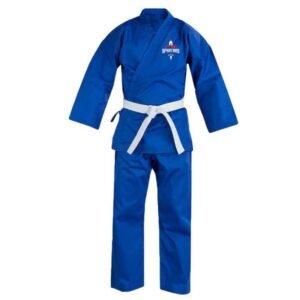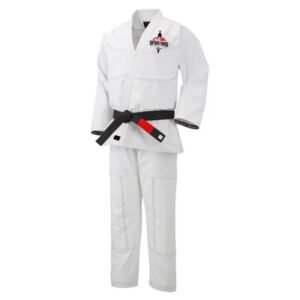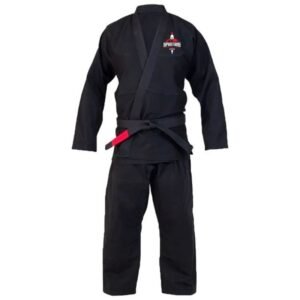Karate Uniform
Our karate uniform, or karategi, is a traditional outfit worn for karate practice and competitions. It consists of a lightweight cotton jacket, pants, and a belt that signifies the practitioner’s rank. The karategi is typically white, symbolizing purity and focus, and is designed for ease of movement, allowing for the high kicks, strikes, and stances used in karate. The fabric varies in thickness depending on the type of training, with lighter versions for mobility and thicker ones for durability in advanced forms and competition.
Karate Uniform
Our karate uniform, or karategi, is a traditional outfit worn for karate practice and competitions. It consists of a lightweight cotton jacket, pants, and a belt that signifies the practitioner’s rank. The karategi is typically white, symbolizing purity and focus, and is designed for ease of movement, allowing for the high kicks, strikes, and stances used in karate. The fabric varies in thickness depending on the type of training, with lighter versions for mobility and thicker ones for durability in advanced forms and competition.
Karate Uniform
Our karate uniform, or karategi, is a traditional outfit worn for karate practice and competitions. It consists of a lightweight cotton jacket, pants, and a belt that signifies the practitioner’s rank. The karategi is typically white, symbolizing purity and focus, and is designed for ease of movement, allowing for the high kicks, strikes, and stances used in karate. The fabric varies in thickness depending on the type of training, with lighter versions for mobility and thicker ones for durability in advanced forms and competition.
Karate Uniform
Our karate uniform, or karategi, is a traditional outfit worn for karate practice and competitions. It consists of a lightweight cotton jacket, pants, and a belt that signifies the practitioner’s rank. The karategi is typically white, symbolizing purity and focus, and is designed for ease of movement, allowing for the high kicks, strikes, and stances used in karate. The fabric varies in thickness depending on the type of training, with lighter versions for mobility and thicker ones for durability in advanced forms and competition.
Karate Uniform
Our karate uniform, or karategi, is a traditional outfit worn for karate practice and competitions. It consists of a lightweight cotton jacket, pants, and a belt that signifies the practitioner’s rank. The karategi is typically white, symbolizing purity and focus, and is designed for ease of movement, allowing for the high kicks, strikes, and stances used in karate. The fabric varies in thickness depending on the type of training, with lighter versions for mobility and thicker ones for durability in advanced forms and competition.
Karate Uniform
Our karate uniform, or karategi, is a traditional outfit worn for karate practice and competitions. It consists of a lightweight cotton jacket, pants, and a belt that signifies the practitioner’s rank. The karategi is typically white, symbolizing purity and focus, and is designed for ease of movement, allowing for the high kicks, strikes, and stances used in karate. The fabric varies in thickness depending on the type of training, with lighter versions for mobility and thicker ones for durability in advanced forms and competition.
Karate Uniform
Our karate uniform, or karategi, is a traditional outfit worn for karate practice and competitions. It consists of a lightweight cotton jacket, pants, and a belt that signifies the practitioner’s rank. The karategi is typically white, symbolizing purity and focus, and is designed for ease of movement, allowing for the high kicks, strikes, and stances used in karate. The fabric varies in thickness depending on the type of training, with lighter versions for mobility and thicker ones for durability in advanced forms and competition.
Karate Uniform
Our karate uniform, or karategi, is a traditional outfit worn for karate practice and competitions. It consists of a lightweight cotton jacket, pants, and a belt that signifies the practitioner’s rank. The karategi is typically white, symbolizing purity and focus, and is designed for ease of movement, allowing for the high kicks, strikes, and stances used in karate. The fabric varies in thickness depending on the type of training, with lighter versions for mobility and thicker ones for durability in advanced forms and competition.


